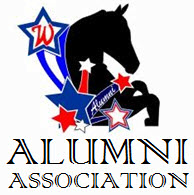The Red Arena Fire of 1986
Westernaires operates all year-round, no matter what the weather may provide. As such, their covered indoor arenas are critical to the organization. We recently remembered the 30th anniversary of the catastrophic fire that burned down the old Red Arena in Fort Westernaire. The event, at that time, was nothing short of devastating to the Westernaires.
The Westernaires Red Arena's exterior, post-fire, March 1986. The fire reached such high temperatures that it melted steel.
The Westernaires Red Arena's interior, post-fire, March 1986. This arena was absolutely essential to Westernaires' ability to practice during the winter months. Three beloved Westernaires rental horses perished in the fire.
Numerous Westernaire horses were inside the building at the time the fire broke out. Golden Animal Hospital veterinarian and close friend of the Westernaires, Dr. John Pallaoro (Doc John), along with other volunteers, arrived and began retrieving the horses from the structure. Doc John and the others repeatedly entered the inferno -- until the Fire Department stopped them and threatened their arrest if they entered the building again.
The fire reached such high temperatures that it melted steel.
Three cherished and popular Westernaire rental string horses perished in the fire: Maria (pronounced "Mariah"), Big Red, and Hot Shot. Many more horses would have perished had it not been for the bravery of Doc John and the other volunteers who were on-site that day.
Volunteers deconstruct what remained of the damaged steel girders in the Red Arena. The old Red Arena's north-facing wall was the only thing remaining in this picture -- taken during Spring / Summer of 1986. Volunteers organized and removed the old steel, while the new steel structural beams were unloaded after transporting them from Independence, Missouri. In this picture: Woody Ellis is on the tractor (blue jacket), while Bruce Slaugh drives on the forklift (plaid shirt). Stu Rydgren (white jacket), Ron Kronauge (red jacket), and Glen Rowell (brown jacket) are on the flatbed.
After tragedy, the Westernaires family always pulls together and perseveres. A Barn-Raising Fundraiser party was held at the Jeffco Auditorium to help raise the funds to purchase the new arena. Westernaires Director, Glen E. Keller, Jr., discovered that the organization had only been $75,000 of loss. The the most affordable bid that the Westernaires received for a replacement structure was $225,000, so this was highly problematic.
The new Red Arena build in-process during the Summer of 1986. It took countless volunteers hundreds of hours of work to complete this project.
Westernaire driver and dad, Bob Massengale, immediately began calling steel companies. One of those companies to which he reached out felt sympathetic to the unfortunate situation. Varco Pruden, a provider of pre-engineered metal buildings, graciously agreed to sell a building to Westernaires at below dealer cost, provided that the Westernaires would go pick it up in Independence, Missouri. Unlike the previous Red Arena building (which was blue in color), this one would actually be red.
The exterior of the "new" Red Arena, dedicated on November 15th, 1986. Unlike the original Red Arena, this one is actually red in color.
The interior of the gorgeous new Red Arena, dedicated in November 15th, 1986. A memorial to Maria, Big Red, and Hot Shot was placed in the concrete flooring of the Red Arena, where it stands to this day.
The new Red Arena building was dedicated on November 15th, 1986. A memorial to Maria, Big Red, and Hot Shot was placed in the concrete flooring of the Red Arena, where it stands to this day.
A memorial to the horses who perished in the fire -- Maria, Big Red, and Hot Shot -- was placed at the arena's threshold.
Westernaires Varsity Big Red Team, the Westernaires board of directors, and other select volunteers were on hand to dedicate the new Red Arena on November 15, 1986. The construction was completed and the facility was ready for practices and performances before the inclement Winter weather arrived, thanks to the hard work of many volunteers.
